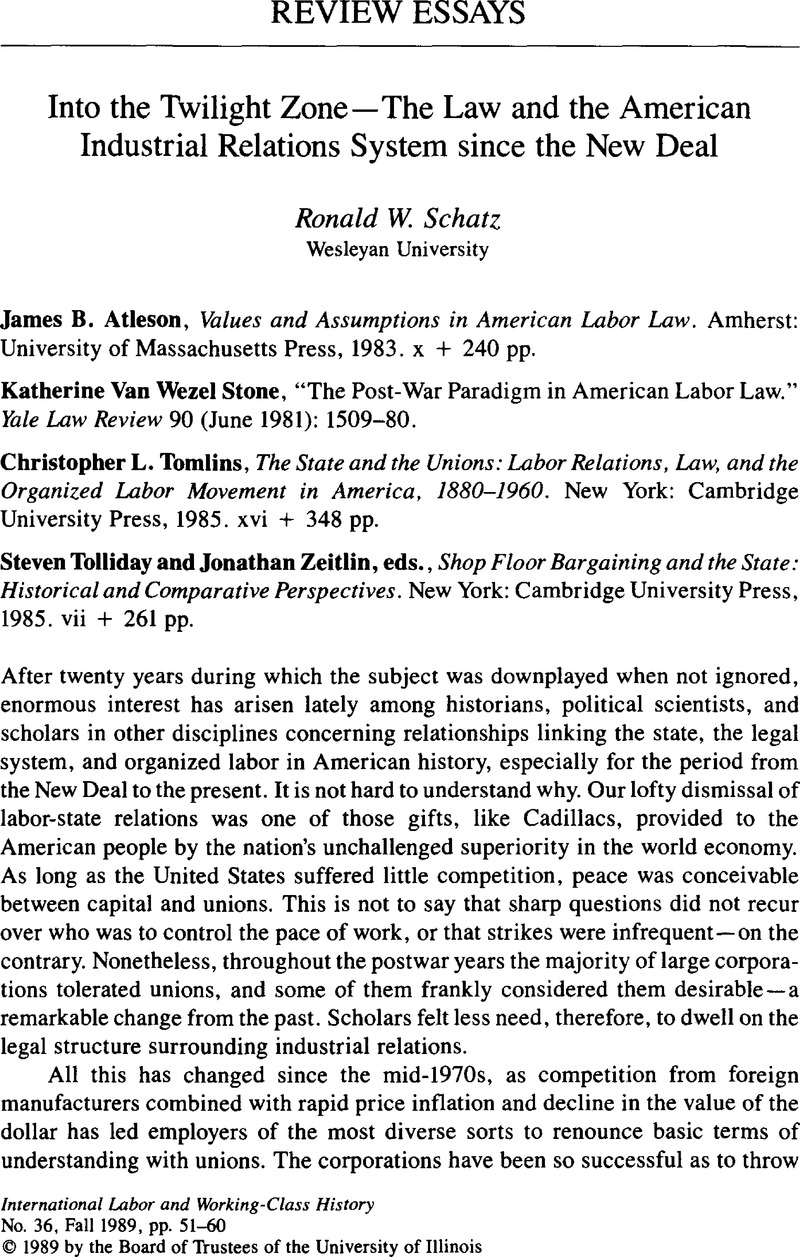Published online by Cambridge University Press: 16 December 2008

1. Klare, Karl E., “Judicial Deradicalization of the Wagner Act and the Origins of Modern Legal Consciousness, 1937–1941,” Minnesota Law Review 62 (1978): 265–339Google Scholar; Klare, Karl E., “Labor Law as Ideology: Toward a New Historiography of Collective Bargaining Law,” Industrial Relations Law Journal 4 (1981): 450–82Google Scholar; Klare, Karl E., “Critical Theory and Labor Relations Law,” in The Politics of Law: A Progressive Critique, ed. Kairys, David (New York, 1982)Google Scholar; Lynd, Staughton, “Government without Rights: The Labor Law Vision of Archibald Cox,” Industrial Relations Law Journal 4 (1981): 483–95.Google Scholar
2. Bernstein, Irving, Turbulent Years: A History of the American Worker 1933–1941 (Boston, 1969), ch. 13Google Scholar; and Gregory, Charles O., Labor and the Law, 2d ed. (New York, 1958), 224.Google Scholar A great exception in this regard is Selig Perlman, who, while fully acknowledging that “the New Deal effected a veritable revolution in American government, comparable to the Jeffersonian and Jacksonian revolutions,” wished that it had not taken place. There are considerable similarities between Perlman's attitude and analysis and that of Christopher Tomlins. See Perlman's, “Labor and the New Deal in Historical Perspective,” in Labor and the New Deal, ed. Derber, Milton and Young, Edwin (Madison, 1957), 361–70.Google Scholar
3. National Labor Relations Board v. Mackay Radio & Telegraph Company, 304 U.S., 333–51.Google Scholar
4. Ibid., 346–47, 351.
5. Cox, Archibald and Dunlop, John T., “Regulation of Collective Bargaining by the National Relations Board,” Harvard Law Review 63 (01 1950), 395.CrossRefGoogle Scholar
6. McDonald, David J., Union Man (New York, 1969), 80–82, 87, 134–35.Google Scholar
7. Consolidated Edison Company Inc., et al. v. NLRB (1938), 305 US.Google Scholar
8. Casebeer, Kenneth M., “Holder of the Pen: An Interview with Leon Keyserling on Drafting the Wagner Act,” University of Miami Law Review 42 (11 1987): 300–301, 309, 313, 316–20ff.Google Scholar
9. Dunlop, John T., “Consensus and National Labor Policy,” in Proceedings of the Thirteenth Annual Meeting, Industrial Relations Research Association, ed. Somers, Gerald G. et al. , (1961), 15.Google Scholar
10. On this point see my “From Commons to Dunlop and Kerr: Rethinking the Field and Practice of Industrial Relations,” in Industrial Democracy: Work Relations in 20th-century AmericaGoogle Scholar, ed. Harris, Howell John and Lichtenstein, Nelson (Cambridge, Mass., forthcoming).Google Scholar